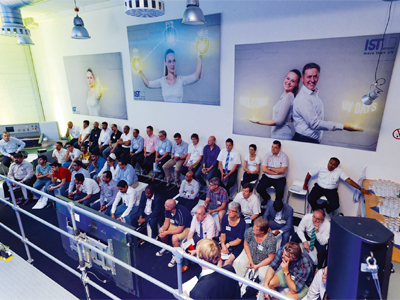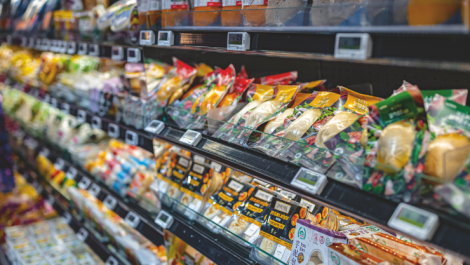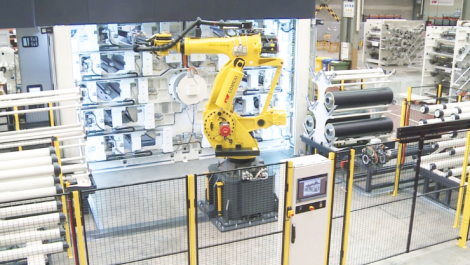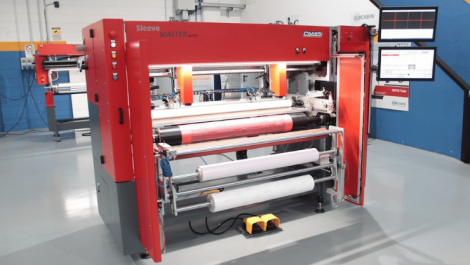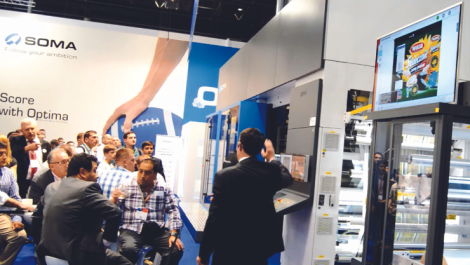UV Days at IST Metz always draws a large audience
The curing of ink using ultraviolet light offers many advantages including improved physical properties, faster production speeds, and reduced set up and cleaning, as well as no harmful emissions and lower energy usage. By Neel Madsen.
Introduced in the 1950s, UV curing gained commercial acceptance in flexographic printing in the late 1980s. One of the main advantages of energy-cured using ultraviolet rays is the absence of solvents and other evaporative components in the ink, making the process more environmentally friendly, further augmented by the lack of drying and associated energy costs.
Used extensively in printing food, pharmaceutical and cosmetic labels, UV curing produces very high quality print with sharp, vibrant colours and excellent coverage.
Even at low press speeds, UV ink will not dry on the plate and can safely be left on the rollers between shifts as long as these are kept out of bright light and direct sunlight. There is therefore less wash up time and the anilox rollers will not need deep cleaning as often. With the lack of solvents, there is also no need for explosion protection or elaborate ventilation systems.
Traditional UV curing systems consist of low pressure mercury arc lamps which emit light with a wave length of between 100 to 300 nanometres (nm). The geometry of the lamp tubes is such that the light is emitted radially and therefore these are housed in a casing with reflectors that direct all the energy onto the substrate.
The lamps emit ultraviolet light causing a polymerisation chain reaction in which the monomers in the ink cross-link and harden to form an ink film on the substrate. This is started by photoinitiators, a type of molecules in the ink that absorb the UV energy and set off the chain reaction.
Modern UV lamps can last up to 4000 to 6000 hours, but this requires a rigorous maintenance programme to prevent degradation in the curing process and avoid issues with the print, such as potential migration of ink components, low rub resistance and tacky ink. However, lamp technology continues to develop with lamp life increasing.
Mark Loveridge, commercial director at UV lamp manufacturer Alpha-Cure, said, ‘UV mercury vapour lamps have been around for years and are used in a variety of processes, predominately in the print industry. Over the years we have been able to increase the useful lamp life and effectiveness of the lamps through the use of more superior components and additional manufacturing processes.’
New in lamps
Headquartered in the UK, Alpha-Cure produces over 160,000 lamps each year. It works to deliver industry advancements in UV lamp design and technology in partnership with leading system manufacturers worldwide.
The company has recently developed the Alpha-Cure microwave lamp, which it describes as the lamp of choice for customers who want minimal downtime, minimum maintenance and maximum product output. As well as graphics arts, it is used in a number of industries, including electronics, fibre optic coating, metal and plastic decorating, finishing and other industrial applications.
A microwave lamp is constructed from a specifically unique design of quartz envelope that contains mercury and metal halide additives to create specific wavelengths of ultraviolet radiation. The addition of metal halides creates a shift in the spectral output, producing longer wavelengths enabling a greater depth of cure. Microwave lamps are commonly known as electrode-less lamps as they don’t require the use of electrodes. Eliminating the electrodes from the lamp removes the risk of primary deterioration, which reduces the lamp life. It also removes the energy loss associated with standard electrode lamps and allows for a narrower lamp design, which reduces the amount of infrared radiation generated, and prevents overheating of heat-sensitive materials near the lamp.
The lamp is irradiated with microwave energy rather than passing current between the electrodes. As space for electrodes is not required, radiation is produced throughout the entire length of the lamp. Significant benefits over electrode lamps include instant on/off capability, no wires so they can withstand harsher environments, longer life (up to five times compared to a standard lamp), greater UV output and a smaller design which can be easily fitted into the system.
Mark Loveridge said, ‘Our microwave lamps are handcrafted to the customer’s exact specification and developed using the most advanced components and cutting edge manufacturing processes. With the highest quality quartz, which is a glass-like material made from silicon dioxide that transmits UV very efficiently, our customers recognise us as worldwide experts in our field.’
Rhino powered
GEW’s UV curing systems are designed for high performance energy-efficient printing presses with applications ranging from narrow web label printing to large format industrial applications working with a wide variety of substrates.
Its E2C UV system with Rhino power supply comes with a comprehensive five-year warranty to avoid any unscheduled downtime and unplanned maintenance costs.
Coveris Flexibles UK Limited, which operates from a site in Cramlington, Northumberland, upgraded its Mark Andy 4150 flexo press with an energy-efficient GEW UV curing system in 2014. The printing company replaced its 20-year-old UV lamps with a new UV curing system, which comprises 10 E2C lampheads with associated Rhino electronic power supply.
Coveris made the investment to support its effort in optimising reliability of production output, increasing uptime and reducing energy consumption. David Dickinson, group engineer at Coveris, commented, ‘With the running cost we had for spare parts and energy, we had come to a point where it was no longer viable to run the old system and we took the decision to upgrade to an alternative and GEW’s Rhino came out at the top.
‘There was an obvious point in favour of Rhino: it comes with a five year parts warranty. Our spend on parts covered the cost of Rhino. On this site we have gone from spending a substantial amount on spare parts down to very little within the next five years and it’s all predictable.’
Roly Banks, site manager at the Cramlington plant, added, ‘We are no longer losing production due to component failure. The new system has improved our productivity massively. The thing we are most comfortable with now is that in the nine months we have run Rhino here the system has been 100% reliable. We’ve had no failures.’
For Coveris operating in a more efficient and reliable set up not only reduces costly stand-by periods and undesirable downtime but is crucial for the dependability of production and thus maintaining valuable business with established customers.
A major advantage of the new UV system is the fast start up and minimised maintenance time with consequently improved production efficiency and reduced downtime. Mr Dickinson said, ‘We are now able to shut the lamps down for a break period which in the past we couldn’t have done. Now over a three shift operation we can save more than an hour and a half per day of running of actual lamp energy.’ Mr Banks added, ‘The short burn-in time has been a big saving for us. We actually shut lamps down for five colour, four colour, three colour jobs, so the energy and time savings are massive.’
The lower temperature output of the system means less heat and CO2 discharge, and the improved curing efficiency of the new E2C lamp and reflector design gave press operators more confidence in running the press faster with less power. In addition the system’s high energy efficiency means that reduced lamp power can be used to run the press, resulting in significantly prolonged lamp life cycles. ‘We were used to changing lamps every 1000 hours and are now pushing forward to changing every 3 to 4000 hours,’ confirmed Mr Banks.
As a result, Coveris has ordered another five systems to harmonise the new technology across the site.
UV event
Founded by Gerhard Metz in 1977, the IST Metz group of companies has today more than 500 employees and 15 subsidiaries in France, the UK, the USA, Italy, the Netherlands, Spain, Sweden, China and Thailand, along with a worldwide network of distributors and partners. UV lamps and electronic components are developed and manufactured by eta plus electronic gmbh and the housing units by gerhard metz metallbau gmbh, while S1 Optics and VTD Vakuumtechnik Dresden carry out optical- and vacuum-coating of the reflectors. All of these individual companies have been integrated into the group.
Together with 30 partners from the printing industry, IST is gearing up for its seventh biannual UV Days event, which was first established in 2002 and has gained in popularity over the years. Taking place at the IST Metz headquarters in Nürtingen, near Stuttgart, the open house is set to receive some 700 guests over the four days.
Three presses will be continuously printing UV products during the event to highlight the versatility of UV technology in the market segments of packaging printing, commercial printing and label printing. In keeping with the motto of the event – ‘UV rocks!’ – a cardboard guitar will be printed and finished live utilising a combination of LED colours and UV varnishes. During the demonstration, curing with both LED and UV will be shown, highlighting the strengths of each drying system during the printing process.
‘We are no longer solely focusing on providing information about UV printing. Although that is, and will remain, our core competence,’ explained Dirk Jägers, managing director of IST Metz GmbH. ‘These days, the overall concept of a printed product must appeal to the consumer, in the higher priced segment especially. Printed products from our company demonstrate the latest possibilities.’
A new feature is the Innovation Corner, where partner companies will be presenting design trends, while experts demonstrate further areas of application, such as adhesives or water treatment. Another highlight this year promises to be the exhibition of printed products that have been recognised with a Print Star award byDeutscher Drucker, which will include exhibits from IST Metz. The UV Lounge where visitors can take a break or network with industry colleagues is also making a return.
Simon Mitchell, joint managing director IST (UK) Ltd, said, ‘UV Days, as always, is a fantastic opportunity to see the latest UV systems and take a close view of the different technologies available within the field of UV. We have a good representation of UK visitors coming to Nürtingen who will experience the developments in LED UV, conventional UV for the print and non-print markets, and above all else this is operational within the facilities at IST. Each visitor can expect to spend time on their own area of interest which clearly is the advantage of having an in-house event like UV Days.’

